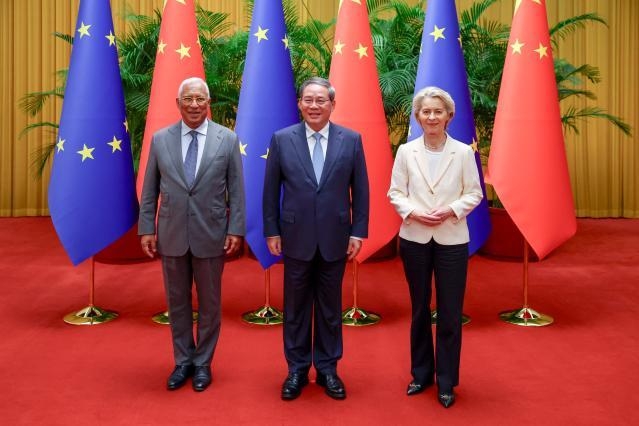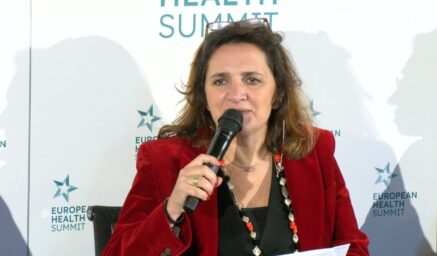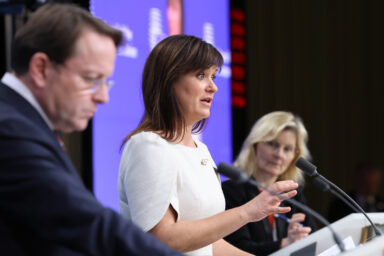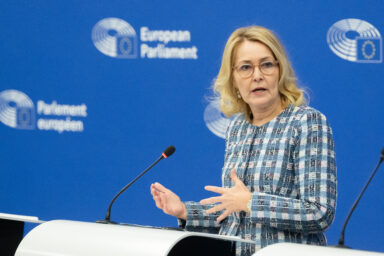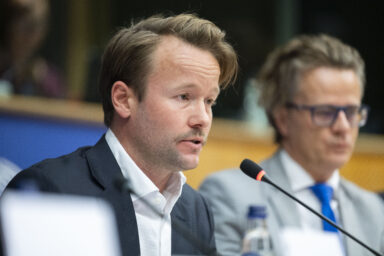The EU-China summit, held on Thursday, 24 July, brought few practical results that would address the growing trade imbalance between the two parties. On the climate side, EU and China agreed to demonstrate leadership together to drive a global just transition and to act as global leaders in climate change policies with COP30 in sight.
Expectations were not high before the EU-China summit though the event was attended by political heavyweights – Commission President Ursula von der Leyen and Council President António Costa on the European side plus President Xi Jinping and Premier Li Qiang on the Chinese side.
According to the Council’s statement released just before the summit, leaders were supposed to first of all discuss ways of ensuring a more balanced, reciprocal and mutually beneficial trade relationship. The other focal points were climate change, biodiversity, and advancing the green transition.
On the trade side, stakes were high especially on the EU’s side. European Union currently faces the threat of high tariffs on goods exported to the United States which the US President Donald Trump plans to launch on 1 August. Though negotiations are under way, it is still possible that Trump’s 30%-or-so tariffs will materialize. If that happens, the access of goods originating from the EU to the American market would be severly limited – with China’s market seen as a possible substitute.
You might be interested
Based on the 2024 data, United States was the biggest EU’s trade partner with total export of goods and services worth some €305bn. EU’s export to China was about half of that figure.
Market access, tariffs, and non-tariff barriers
Regarding trade, however, the summit clearly brought no practical results. This fact was echoed by both EU leaders during the press conference held immediately after the summit. Ms von der Leyen reminded the audience that the trade imbalance between EU and China keeps growing with Chinese export to the EU vastly outnumbering European export to China.
A lack of market access, tariffs, and non-tariff barriers are three main issues related to EU-China trade. – Commission President Ursula von der Leyen
“There are three main issues related to EU-China trade. This is the lack of market access, tariffs, and non-tariff barriers on the Chinese side (…) Among the non-tariff barriers, as an example, is the ‘Buy China principle‘ often used by Chinese authorities which does not allow the European companies to compete in a fair way. Also important is the export control like in the field of critical raw materials,” the Commission President complained without mentioning any progress made in this respect.
Mr Costa used a similar tone. “As EU and China combined account for more than one third of global GDP, having a fair balance in mutual trade is essential,” the Council President said, and added: “Now it is time to make further progress.” Again, with no mention of any practical steps.
Chinese leaders did not attend the press conference.
EU and China are major trading partners. In 2024, the bilateral trade relationship was worth €730bn. However, these trade relations remain critically unbalanced, with the trade deficit in goods (seen from the EU side) reaching €305bn.
Together as world leaders towards COP30?
More common ground between EU and China was found regarding the climate policy. This fact is mirrored in the joint EU-China press statement on climate. The document demonstrates “common leadership to drive a global just transition in the context of sustainable development and poverty eradication” and confirms concrete commitments. These include accelerating the global renewable energy deployment, turning respective climate targets into tangible outcomes through concrete actions and measures, as well as “working with all parties to support Brazil in hosting a successful United Nations Climate Change Conference (COP30).”
COP30 will be held in Brazil in November 2025. With the United States under President Donald Trump being temporarily “out of the game”, EU and China are now seen as two global leaders pushing the climate agenda. Though in Europe tackling the climate change lies in the core of EU’s policy, in China – still the world’s biggest polluter – this is a relative novelty. However, climate efforts now seem to be in China’s national interest: the clean technology economy has surged, with exports of products such as batteries, solar panels, and electric vehicles becoming key drivers for the Chinese economy.
EU and China are both expected to submit new targets for reducing emissions until 2035 ahead of the COP30. Whether more nations will follow remains to be seen.
